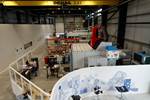Sino Polymer develops high-performance epoxy resin prepreg
Used in railway applications, the carbon fiber prepreg can be cured at 150℃ for 10 minutes, and is suitable for structural parts requiring Tg within 120-140℃.
Originally focused on aerospace and military application, (Shanghai, China), has recently developed high-performance epoxy resin systems, including EN45545, a flame-retardant epoxy resin system for carbon fiber prepreg that can be used in railway applications. The system retains halogen-free and low smoke density/toxicity properties and a long shelf life.
Using this epoxy resin system, Sino Polymer says, its carbon fiber (T-300) prepreg has recently passed the EU EN45545-2 R1 test and reached HL3, the highest flame-retardant level. Further, the company notes the prepreg can be cured at 150℃ for 10 minutes, is suitable for structural parts requiring Tg within 120-140 ℃, retains a shelf life at room temperature (60 days at 21-23 ℃) and can be stored for up to 18 months at 18 ℃.
Sino Polymer has also developed systems for wind energy and marine applications, including two room temperature, fast-curing component epoxy resins to infuse with fiberglass for fabricating FRP wind turbine parts and boats, which can be cured in 1.5-2 hours, and two-component epoxy resins for carbon fiber wind blade spar caps using a pultrusion process. Other systems are available for processes such as hand layup and filament winding.
This post is courtesy of the ÂÌñÏ×ÆÞ and media partnership.
Related Content
-
Honda begins production of 2025 CR-V e:FCEV with Type 4 hydrogen tanks in U.S.
Model includes new technologies produced at Performance Manufacturing Center (PMC) in Marysville, Ohio, which is part of Honda hydrogen business strategy that includes Class 8 trucks.
-
Composites end markets: Batteries and fuel cells (2024)
As the number of battery and fuel cell electric vehicles (EVs) grows, so do the opportunities for composites in battery enclosures and components for fuel cells.
-
SRI develops scalable, infiltration-free ceramic matrix composites
Work in two DOE projects is demonstrating C/C-SiC produced in 3-5 days with <5% shrinkage, <10% porosity and 50% the cost of conventional C/C and C/C-SiC.




